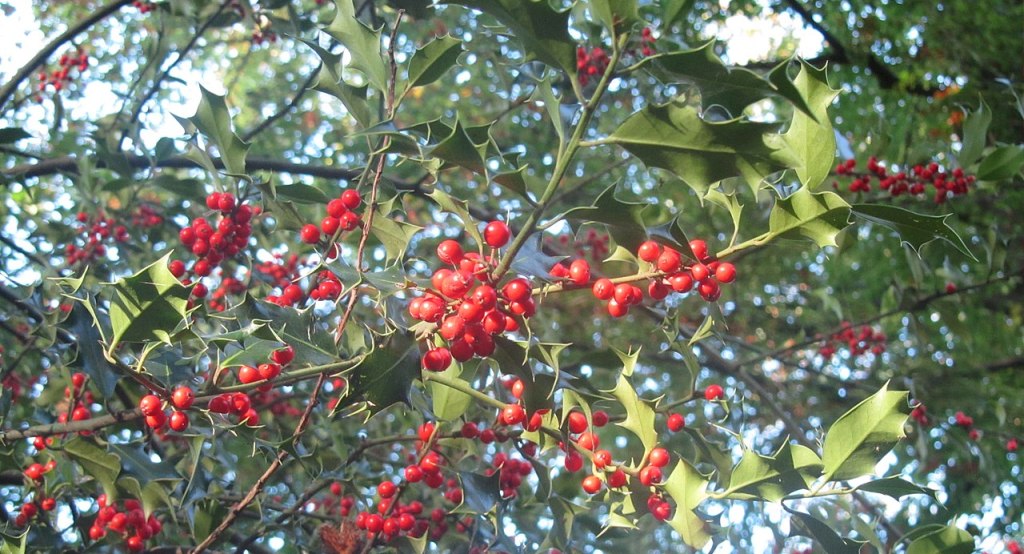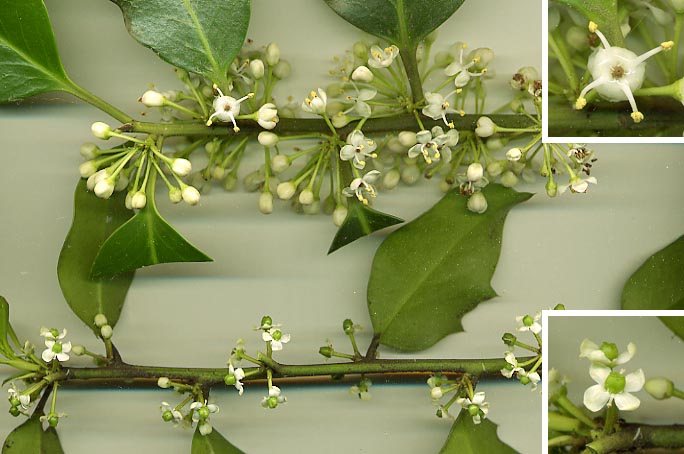As we are nearing the Christmas season, the Holly becomes more prominent.

Somehow I am noticing their dark, glossy green appearance more when the other trees have lost their autumnal leaves.
Its scientific name is Ilex aquifolium and it is the only native species of the genus and Family Aquifoliaceae on the British Isles.
It is special as it is one of very few native evergreen trees.
Read more about this interesting evergreen native and all its uses on the next page.
Most information provided with thanks from Wikipedia and other websites.
Contents:
Ilex aquifolium or Holly
Folklore and tradition
Wildlife Uses:
Former; Other and Amenity Uses:
Ilex × altaclerensis or Highclere Holly
Ilex aquifolium or Holly
An evergreen shrub or tree of deciduous woodlands and wood-pasture, especially those on acidic soils in which Fagus sylvatica and Quercus predominate; often a frequent or locally dominant undershrub but rarely dominating the canopy. Its susceptibility to heavy browsing can limit regeneration. It is also found in scrub and hedgerows, and on ledges of acidic cliffs, and is often planted in amenity areas and parkland.
The flowers are a simple structure and it is not easy to tell whether they are male or female. Holly is dioecious, meaning that there are separate male and female plants.

The fruit only appears on female plants, which require male plants nearby to fertilise them. The fruit is a drupe (stone fruit), about 6–10 mm in diameter, a bright red or bright yellow, which matures around October or November; at this time they are very bitter due to the ilicin content and so are rarely eaten until late winter after frost has made them softer and more palatable. Each fruit contains 3 to 4 seeds which do not germinate until the second or third spring.

Folklore and tradition:
Holly has been used to decorate homes and holy places for centuries, indeed millennia. John Claudius Loudon in his Trees and Shrubs of Great Britain notes that evergreens were used in places of worship in pre-Christian times (pine, cedar, fir and box). Holly with its evergreen leaves (with their prickles) were placed at the entrance of a house because they were thought to stop ‘evil forces’ entering. In the Roman festival of Saturnalia, branches of Holly were used to symbolise ‘good wishes’.
An early reference to the use of Holly at Christmas time can be found in Stowe’s ‘Survey of London’ (1598) which says ‘every man’s house, ….. the corners of streets were decorated with holme‘ (holme = holly). Various carols dating back many years also make reference to the use of Holly at Christmas. Holly, Ivy and Mistletoe are all associated with the festive season. All are evergreen plants, whose foliage tends to last quite well in garlands, wreaths and other displays. Whilst the berries of Holly are bright and attractive, they are also toxic.
Holly berries contain alkaloids, caffeine, theobromine, saponins, caffeic acid, and a yellow pigment, ilixanthin. The berries are generally regarded as toxic to humans. Accidental consumption may occur by children or pets attracted to the bright red berries. The berries are emetic, possibly due to the compound ilicin. Caffeine and theobromine found in the plant are generally toxic to dogs and cats.
Wildlife Uses:
The evergreen branches are good shelter for birds and deer, in which they can take refuge. After the first frost of the season, holly fruits become soft and fall to the ground serving as important food for winter birds at a time of scarce resources. They are also eaten by rodents and larger herbivores.
The flowers are attractive as nectar sources for insects such as bees, wasps, flies, and small butterflies.
The commonly-encountered pale patches on leaves are due to the leaf-mine insect Phytomyza ilicis.
Former uses:
Between the thirteenth and eighteenth centuries, before the introduction of turnips, holly was cultivated for use as winter fodder for cattle and sheep. Less spiny varieties of holly were preferred, and in practice the leaves growing near the top of the tree have far fewer spines, making them more suitable for fodder.
The Exmoor Ponies and cattle have been introduced at Sutton Park as a conservation matter to keep holly and other dominant species under control. You can read more in the links above.
Other Uses:
- The wood of Holly was used in joinery, cabinet making, engineering, the making of mathematical instruments, wood engraving and veneering. It was once among the traditional woods for Great Highland bagpipes.
The wood is essentially white (except for the heart wood) and accepts dyes readily – so when dyed black, it was sometimes used as a substitute for ebony (on the handles of tea pots). On the Continent, it was used in making whip handles and walking sticks.
- The leaves of yerba mate, also in the genus Ilex, are used to make a caffeinated beverage called mate or Paraguayan tea.
In traditional medicine, holly is supposed to be diuretic, a relief from fever, and a laxative.
Amenity Uses:
Ilex aquifolium is widely grown in parks and gardens in temperate regions. Hollies are often used for hedges; the spiny leaves make them difficult to penetrate, and they take well to pruning and shaping.
AGM cultivars
Numerous cultivars have been selected, of which the following have gained the Royal Horticultural Society‘s Award of Garden Merit:
- I. aquifolium
- ‘Amber’ (female)
- ‘Argentea Marginata’ (female)
- ‘Ferox Argentea’
- ‘Golden Queen’
- ‘Handsworth New Silver’
- ‘J.C. van Tol’ (female)
- ‘Madame Briot’ (female)
- ‘Pyramidalis’ (ideal for narrower spaces)
- ‘Silver Queen’
Ilex × altaclerensis (I. aquifolium x I. perado) or Highclere Holly
The ‘other’ holly you may come across is the hybrid Ilex × altaclerensis, which was developed at Highclere Castle in Hampshire, England, in 1835.
A large evergreen shrub or small tree widely planted and sometimes self-sown shrub in woods, especially on large estate, hedges, parks, churchyards and cemeteries, gardens and quarries, and on banks of rivers and streams, roadsides and waste ground; it also occurs as a relic of cultivation. The hybrid is fully fertile.
This is a cross between I. aquifolium and the tender species I. perado. It, and especially the ornamental cultivars of this garden species may occasionally escape by seed into nature but certainly not as common as our native Holly.
A good Garden Cultivar is:
Ilex × altaclerensis ‘Golden King’
